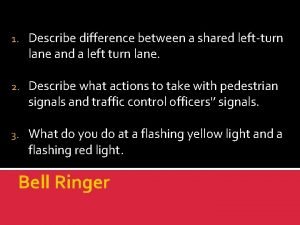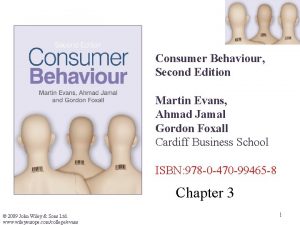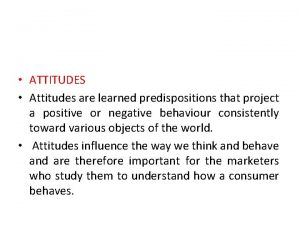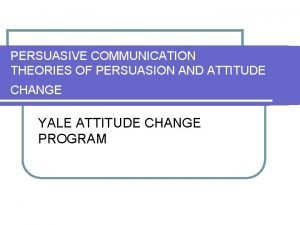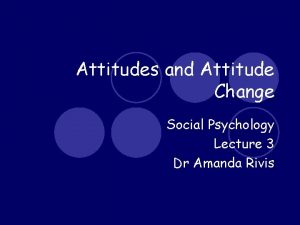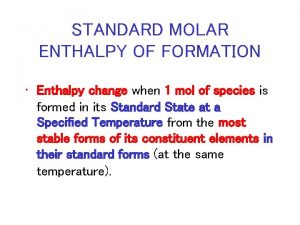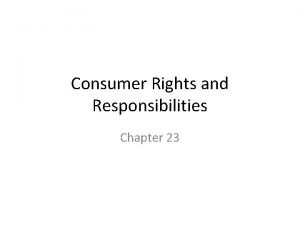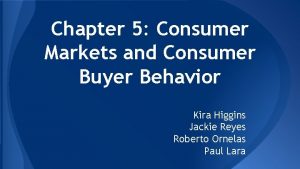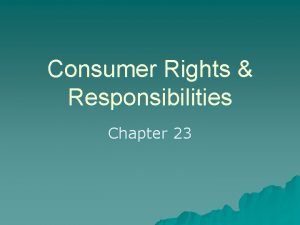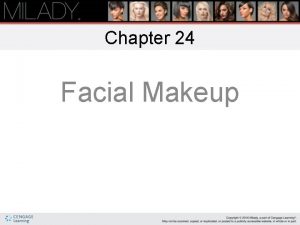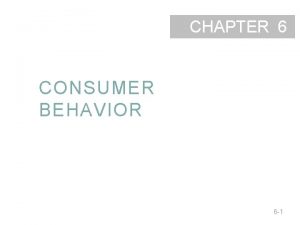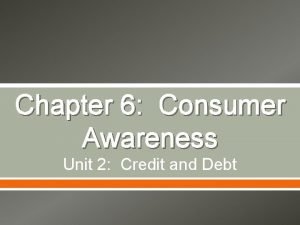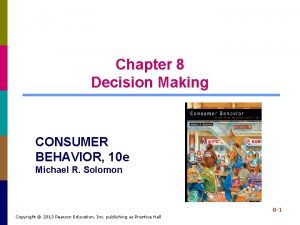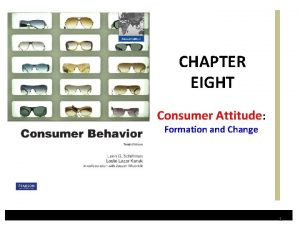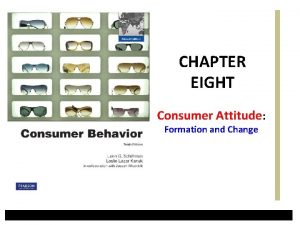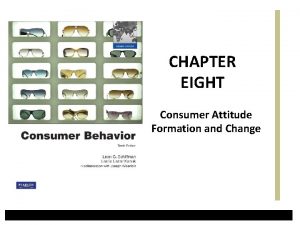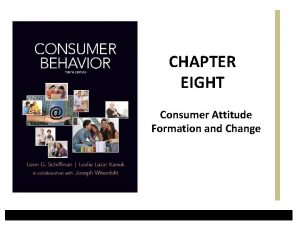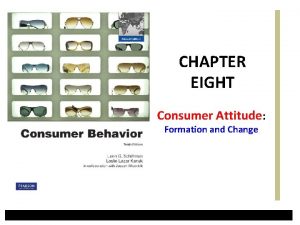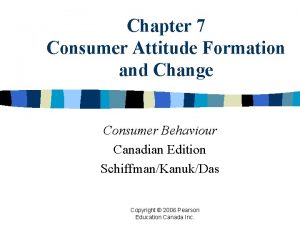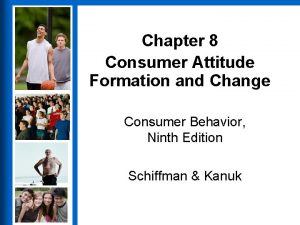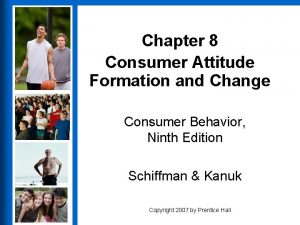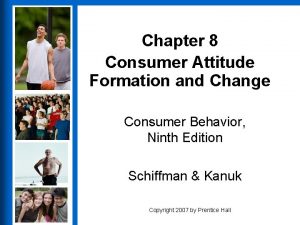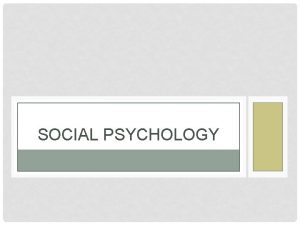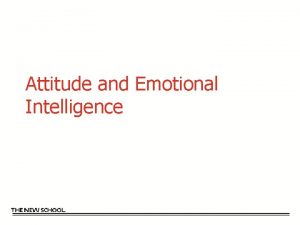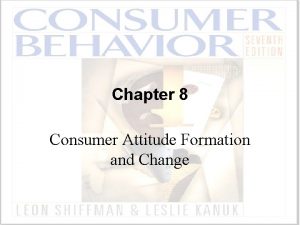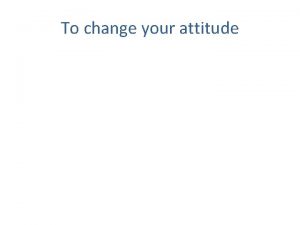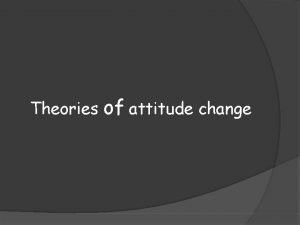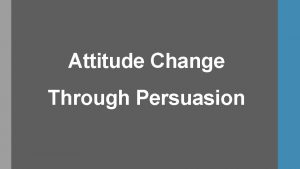CHAPTER EIGHT Consumer Attitude Formation and Change What
























































- Slides: 56

CHAPTER EIGHT Consumer Attitude Formation and Change

What Is Your Attitude Toward the Product Advertised? What Is Your Attitude Toward the Ad Itself? Are the Two Attitudes Similar or Different? Copyright 2010 Pearson Education, Inc. Publishing as Prentice Hall Chapter Eight Slide 2

Attitude A learned predisposition to behave in a consistently favorable or unfavorable manner with respect to a given object. Copyright 2010 Pearson Education, Inc. Publishing as Prentice Hall Chapter Eight Slide 3

-We have attitudes toward many things – to people, products, advertisements, ideas, and more. - For the most part, these attitudes have been learned and guide our behavior toward the object. -This web link brings you to one of many sites that helps measure attitudes via online surveys. 4

What Are Attitudes? • • The attitude “object” Attitudes are a learned predisposition Attitudes have consistency Attitudes occur within a situation Copyright 2010 Pearson Education, Inc. Publishing as Prentice Hall Chapter Eight Slide 5

-It is important to understand these four concepts. The first is that we must clearly define the object which we are discussing or measuring the attitude toward. - Is it a product category, a specific brand, or a particular model? The second is the agreement among researchers that attitudes are learned, either through direct experience or from others. - Attitudes are consistent, they are not necessarily permanent and can change over time. - We all know how our attitude can be affected by a situation – think about the times you have to eat foods that are not necessarily your favorite but they are what is available or what you are being served at a friend’s house. 6

Structural Models of Attitudes 1 -Tricomponent Attitude Model 2 -Multiattribute Attitude Model 3 -The Trying-to-Consume Model 4 -Attitude-Toward-the-Ad Model • These are models that attempt to understand the relationships between attitude and behavior. They will be explained in more detail on the following slides. Copyright 2010 Pearson Education, Inc. Publishing as Prentice Hall Chapter Eight Slide 7

A Simple Representation of the Tricomponent Attitude Model - Figure 8. 3 Cognition Copyright 2010 Pearson Education, Inc. Publishing as Prentice Hall Chapter Eight Slide 8

-The tricomponent attitude model has three components, as seen on this figure – the cognitive, affective, and conative components. -Each of these will be explained in more detail in the slides that follow. 9

First: The Tricomponent Model Components 1 -Cognitive 2 -Affective 3 -Conative Copyright 2010 Pearson Education, Inc. Publishing as Prentice Hall The knowledge and perceptions that are acquired by a combination of direct experience with the attitude object and related information from various sources Chapter Eight Slide 10

-The cognitive component is what you know or think about an object. - This can be formed through direct experience or what you learn from others. -The knowledge you form becomes a belief. 11

The Tricomponent Model Components • Cognitive 2 -Affective • Conative A consumer’s emotions or feelings about a particular product or brand Copyright 2010 Pearson Education, Inc. Publishing as Prentice Hall Chapter Eight Slide 12

-How you feel about a brand, the emotions you have toward it, constitutes the affective component of the model. - These feelings often tend to be overall good or bad feelings. 13

The Tricomponent Model Components • Cognitive • Affective 3 -Conative The likelihood or tendency that an individual will undertake a specific action or behave in a particular way with regard to the attitude object Copyright 2010 Pearson Education, Inc. Publishing as Prentice Hall Chapter Eight Slide 14

-The conative component describes the likelihood that you will do something in regard to the object. -One of the most important is your intention to buy a certain object. 15

Second: Multiattribute Attitude Models Attitude models that examine the composition of consumer attitudes in terms of selected product attributes or beliefs. Copyright 2010 Pearson Education, Inc. Publishing as Prentice Hall Chapter Eight Slide 16

-Just as the name implies, these are models that breakdown overall attitude into the attributes or beliefs which form an overall opinion. - There are several of these models, as you will see on the next few slides. 17

2 -Multiattribute Attitude Models Types 1 -The attitude-towardobject model 2 -The attitude-towardbehavior model 3 -Theory-of-reasonedaction model • Attitude is function of the presence of certain beliefs or attributes. • Useful to measure attitudes toward product and service categories or specific brands. Copyright 2010 Pearson Education, Inc. Publishing as Prentice Hall Chapter Eight Slide 18

-According to the attitude-toward-object model, consumers will like a brand or product that has an adequate level of attributes that the consumer thinks are positive. - For example, if you are buying a home, there is a list of attributes that the home must have – 2 bedrooms, 2 bathrooms, air conditioning, and a back yard -With this model, an attitude is positive for the house that has the most of these attributes. 19

Multiattribute Attitude Models Types • The attitude-towardobject model 2 -The attitude-towardbehavior model • Theory-of-reasonedaction model • Is the attitude toward behaving or acting with respect to an object, rather than the attitude toward the object itself • Corresponds closely to actual behavior Copyright 2010 Pearson Education, Inc. Publishing as Prentice Hall Chapter Eight Slide 20

-Instead of asking people what product they like and have positive attitudes toward, the attitude-toward-behavior model is based on how positive someone's attitude is toward acting a certain way, for instance purchasing a certain brand. -The question is now how likely are you to purchase brand X rather than how highly do you rate brand X. 21

Consumer Characteristics, Attitude, and Online Shopping Copyright 2010 Pearson Education, Inc. Publishing as Prentice Hall Chapter Eight Slide 22

-This is a model that looks at people’s attitudes toward purchasing online. - On the lefthand side are the consumer characteristics that tend to impact a person’s attitude toward purchasing online. - Their attitude was broken down further by how they view nine benefits of online shopping, including effectiveness, convenience, information, safety, service, delivery speed, web design, selection, and familiarity with company name. - In addition, the attitude leads to how a consumer will rate an online shopping experience. 23

Multiattribute Attitude Models Types • The attitude-towardobject model • The attitude-towardbehavior model 3 -Theory-of-reasonedaction model • Includes cognitive, affective, and conative components • Includes subjective norms in addition to attitude Copyright 2010 Pearson Education, Inc. Publishing as Prentice Hall Chapter Eight Slide 24

-we also need to understand subjective norms or how a consumer is influenced by others 25

A Simplified Version of the Theory of Reasoned Action - Figure 8. 5 Copyright 2010 Pearson Education, Inc. Publishing as Prentice Hall Chapter Eight Slide 26

Third: Theory of Trying to Consume An attitude theory designed to account for the many cases where the action or outcome is not certain but instead reflects the consumer’s attempt to consume (or purchase). Copyright 2010 Pearson Education, Inc. Publishing as Prentice Hall Chapter Eight Slide 27

-The theory of trying to consume addresses the fact that many people may want to purchase but in many cases they cannot. - This may occur for personal reasons, such as not having enough money, or environmental reasons, such as not being able to go to a particular store. 28

Selected Examples of Potential Impediments That Might Impact Trying - Table 8. 7 POTENTIAL PERSONAL IMPEDIMENTS • • • “I wonder whether my hair will be longer by the time of my wedding. ” “I want to try to lose two inches off my waist by my birthday. ” “I’m going to try to get tickets for the Rolling Stones concert for our anniversary. ” “I’m going to attempt to give up smoking by my birthday. ” “I am going to increase how often I run two miles from three to five times a week. ” “Tonight, I’m not going to have dessert at the restaurant. ” POTENTIAL ENVIRONMENTAL IMPEDIMENTS • “The first 1, 000 people at the baseball game will receive a team cap. ” • “Sorry, the car you ordered didn’t come in from Japan on the ship that docked yesterday. ” • “There are only two cases of chardonnay in our stockroom. You better come in sometime today. ” • “I am sorry. We cannot serve you. We are closing the restaurant because of an electrical problem. ” Copyright 2010 Pearson Education, Inc. Publishing as Prentice Hall Chapter Eight Slide 29

-There are many reasons why people do not consume even if they want to purchase a product. - Table 8. 7 in the text gives examples of both personal and environment impediments. - How many times have these reasons stopped you from purchasing? What can marketers do to remove these impediments? 30

Fourth: Attitude. Toward-the. Ad Model A model that proposes that a consumer forms various feelings (affects) and judgments (cognitions) as the result of exposure to an advertisement, which, in turn, affect the consumer’s attitude toward the ad and attitude toward the brand. Copyright 2010 Pearson Education, Inc. Publishing as Prentice Hall Chapter Eight Slide 31

-The attitude-toward-the-ad model helps us understand how advertising impacts attitudes. -The model is more thoroughly diagramed on the next slide. 32

A Conception of the Relationship Among Elements in an Attitude-Toward-the-Ad Model Figure 8. 6 Copyright 2010 Pearson Education, Inc. Publishing as Prentice Hall Chapter Eight Slide 33

-Here we see that everything begins with exposure to the ad. - After this exposure, the consumer has feelings (affect) and thoughts (cognition) regarding the ad. -This forms an attitude which works with beliefs about the brand to help form an attitude toward the brand. 34

Issues in Attitude Formation • How attitudes are learned 1 -Conditioning and experience 2 -Knowledge and beliefs 1 - Sources of influence on attitude formation – Personal experience – Influence of family – Direct marketing and mass media 2 -Personality factors Copyright 2010 Pearson Education, Inc. Publishing as Prentice Hall Chapter Eight Slide 35

-Attitudes are formed through learning. -Recalling the concepts of classical and operant conditioning from earlier chapters, we recall that two stimuli can be paired or linked together to form a learned response. - In addition, consumers can learn attitudes from rewards or outcomes from behavior. -If attitudes are learned, then it is through experiences that this learning occurs. 36

-This can be from personal experience or from experiences with friends or exposure to marketing influences. -Another topic studied in an earlier chapter comes into play with attitude formation. -This is the consumer’s need for cognition. -People will form attitudes based on the information that best suits them, information for the high need for cognition consumer, and images and spokespeople for the low need for cognition. 37

Strategies of Attitude Change 1 -Changing the Basic Motivational Function 2 -Associating the Product with an Admired Group or Event 3 -Resolving Two Conflicting Attitudes 4 -Altering Components of the Multiattribute Model 5 -Changing Beliefs about Competitors’ Brands Copyright 2010 Pearson Education, Inc. Publishing as Prentice Hall Chapter Eight Slide 38

-Here are five strategies for attitude change. -If you think about it, attitude change and formation are not all that different. -They are both learned, they are both influenced by personal experience, and personality affects both of them 39

1 -Changing the Basic Motivational Function Utilitarian Egodefensive Valueexpressive Knowledge Copyright 2010 Pearson Education, Inc. Publishing as Prentice Hall Chapter Eight Slide 40

-Changing the basic motivational function means to change the basic need that a consumer is trying to fulfill. - Utilitarian function is how the product is useful to us. A marketer might want to create a more positive attitude toward a brand by showing all it can do. - An ego-defensive function would show the product would make them feel more secure and confident. - A value-expressive function would more positively reflect the consumer’s values, lifestyle, and outlook 41

- Finally, the knowledge function would satisfy the consumer’s “need to know” and help them understand more about the world around them. -It is important for marketers to realize that they might have to combine functions because different customers are motivated to purchase their products for different reasons. -Someone might buy a product because it tastes good and fills them up (utilitarian), while another thinks it is low fat and will make them healthy and therefore look better (ego-defensive). 42

2 -Associating the Product with an Admired Group or Event • Attitudes are related to certain groups, social events, or causes. • It is possible to alter attitudes toward companies and their products, services, and brands by pointing out their relationship to particular social groups, event, or causes. • Recent study has investigated the relationship between the “causes” and the “sponsor”. • One study found that while both the brand the causes benefit from such alliances, a low familiar causes benefited more from its association with a 43 positive brand than did a highly familiar causes.

3 - Resolving two conflicting attitudes • Attitude-change strategies can sometimes resolve or potential between two attitudes. • Specifically, if consumers can be to see that their negative attitude toward a product, a specific brand, or its attributes is really not in conflict with another attitude, they may be induced to change their evaluation of the brand. 44

4 - Altering components of the Multiattribute model • Altering Components of the Multiattribute Model – Changing relative evaluation of attributes – Changing brand beliefs – Adding an attribute – Changing the overall brand rating Copyright 2010 Pearson Education, Inc. Publishing as Prentice Hall Chapter Eight Slide 45

- If we think analytically about a multi attribute model, we realize there are many different attributes that make up an overall attitude. - As marketers, we can change the way the consumer evaluates a certain attribute. Perhaps the consumer thinks inexpensive is fine for a product, but a marketer might be able to point out that it is often worth paying a bit more for better quality. - A marketer can also change the way consumers believe a brand rates on a certain attribute. - Maybe a consumer thinks a brand is very expensive when in fact it is less expensive then several other brands. 46

-There may be an attribute that does not even exist. -Who thought chewiness was an attribute that could even exist for a vitamin until Gummy Vites came along. 4 -Changing Beliefs about Competitors’ Brands -Finally, we can step away from looking individually at the attribute and attempt to change the consumer’s overall assessment of the brand. -We can do any of these attitude change strategies by changing beliefs of our own product or our competitor's product. 47

Elaboration Likelihood Model (ELM) Customer attitudes are changed by two distinctly different routes to persuasion: a central route or a peripheral route. Copyright 2010 Pearson Education, Inc. Publishing as Prentice Hall Chapter Eight Slide 48

-The ELM is a much more global view of attitude change than the models reviewed on the previous slide. - A more detailed description is provided in a diagram on the next slide. 49

Elaboration Likelihood Model Copyright 2010 Pearson Education, Inc. Publishing as Prentice Hall Chapter Eight Slide 50

Behavior Can Precede or Follow Attitude Formation Cognitive Dissonance Theory • Holds that discomfort or dissonance occurs when a consumer holds conflicting thoughts about a belief or an attitude object. Copyright 2010 Pearson Education, Inc. Publishing as Prentice Hall Attribution Theory • A theory concerned with how people assign causality to events and form or alter their attitudes as an outcome of assessing their own or other people’s behavior. Chapter Eight Slide 51

-On the left-hand side of the model, we see central variables on the top and peripheral variables on the bottom. -Central variables, which lead to the central route, will be effective on highly-motivated consumers. -They will do the thinking necessary to understand the information they are presented. -Peripheral variables, including music, spokespeople, and bright packaging, work on lowerinvolvement consumers. -Together, or alone, they create an attitude change that results in a certain behavior. 52

Attribution Theory • Self-Perception Theory – Foot-in-the-Door Technique • Attributions toward Others • Attributions toward Things • How We Test Our Attributions – Distinctiveness – Consistency over time – Consistency over modality – Consensus Copyright 2010 Pearson Education, Inc. Publishing as Prentice Hall Chapter Eight Slide 53

-Here are some interesting issues in attribution theory. -Self-perception theory is the inferences or judgment as to the causes of your behavior. -Did something happen, like you won an award, because you were really good, because the competition was weak, or because the judges were rushed? We are constantly examining our behavior and often try to stay consistent. -This is considered the foot-in-the-door technique, the fact that if you say yes to something, you will probably say yes to a similar act later on to remain consistent in your behavior. 54

-We have attribution toward others and always ask ourselves “why” about other’s acts. We question their motives. -Would you believe we also have attribution toward things? Do you sometimes ask yourself, “Why do I like this software or that movie so much? ” -Over time, we like to test our attributions to see if they are correct. We may decide that if something happens when we use this product, it has distinctiveness. 55

We also see if we have the same reaction to behavior over time, in different situations (modality), and if others agree. - -There are thousands of dating services online. -This web link goes to therightstuff. com, a dating service for Ivy-league graduates only. -People have a certain attribution toward others who attend the same colleges or group of colleges as themselves. - Because they had this behavior (attended an Ivy League school) they must be like me. 56
 Primary consumers are
Primary consumers are A polygon with eight sides and eight angles
A polygon with eight sides and eight angles A short section of corrugated roadway that warns of hazards
A short section of corrugated roadway that warns of hazards Analyzing consumer markets and buyer behavior
Analyzing consumer markets and buyer behavior Consumer markets and consumer buyer behavior
Consumer markets and consumer buyer behavior Attitude formation
Attitude formation You attitude examples
You attitude examples Attitude and value change
Attitude and value change Omnivore desert animals
Omnivore desert animals Cengage
Cengage Consumer behaviour research process
Consumer behaviour research process Yale attitude change approach to persuasion
Yale attitude change approach to persuasion Attitude change
Attitude change Formation initiale vs formation continue
Formation initiale vs formation continue How to calculate enthalpy change
How to calculate enthalpy change Bread toasting: gas formation color change light emission
Bread toasting: gas formation color change light emission Enthalpy change of combustion definition a level
Enthalpy change of combustion definition a level Chemical change formation of precipitate
Chemical change formation of precipitate Chemical change formation of precipitate
Chemical change formation of precipitate What is enthalpy change
What is enthalpy change Summary of chapter 8 gatsby
Summary of chapter 8 gatsby Lord of the flies chaoter 8 summary
Lord of the flies chaoter 8 summary Physical change
Physical change Absolute change and relative change formula
Absolute change and relative change formula Difference between a chemical and physical change
Difference between a chemical and physical change Change in supply and change in quantity supplied
Change in supply and change in quantity supplied Examples of physical vs chemical changes
Examples of physical vs chemical changes Rocks change due to temperature and pressure change
Rocks change due to temperature and pressure change Whats the difference between physical and chemical changes
Whats the difference between physical and chemical changes First and second order change in education
First and second order change in education Responsibilities of a consumer
Responsibilities of a consumer Chapter 23 consumer rights and responsibilities
Chapter 23 consumer rights and responsibilities Chapter 1 consumer powers and protections
Chapter 1 consumer powers and protections Chapter 5 consumer markets and buyer behavior
Chapter 5 consumer markets and buyer behavior Chapter 23 consumer rights and responsibilities
Chapter 23 consumer rights and responsibilities Chapter 6 consumer purchasing and protection
Chapter 6 consumer purchasing and protection Venn diagram of mechanical and chemical weathering
Venn diagram of mechanical and chemical weathering Painting a wall physical or chemical change
Painting a wall physical or chemical change Two negative integers
Two negative integers Change in supply vs change in quantity supplied
Change in supply vs change in quantity supplied Enagic founder
Enagic founder Proactive vs reactive change
Proactive vs reactive change Spare change physical versus chemical change
Spare change physical versus chemical change When does a physical change occur study jams
When does a physical change occur study jams Which is an example of a physical change
Which is an example of a physical change Chopping wood a physical or chemical change
Chopping wood a physical or chemical change Climate change 2014 mitigation of climate change
Climate change 2014 mitigation of climate change Robert pushes the box to the left
Robert pushes the box to the left It has 6 rectangular faces 8 corners and 12 edges
It has 6 rectangular faces 8 corners and 12 edges Bell and hart's eight causes of conflict
Bell and hart's eight causes of conflict Milady makeup chapter
Milady makeup chapter Eight brief tales of lovers
Eight brief tales of lovers Forty and eight
Forty and eight Chapter 7 consumer behavior
Chapter 7 consumer behavior Chapter 6 consumer behavior
Chapter 6 consumer behavior What are the four common marketing tactics
What are the four common marketing tactics Stages in consumer decision making process
Stages in consumer decision making process


